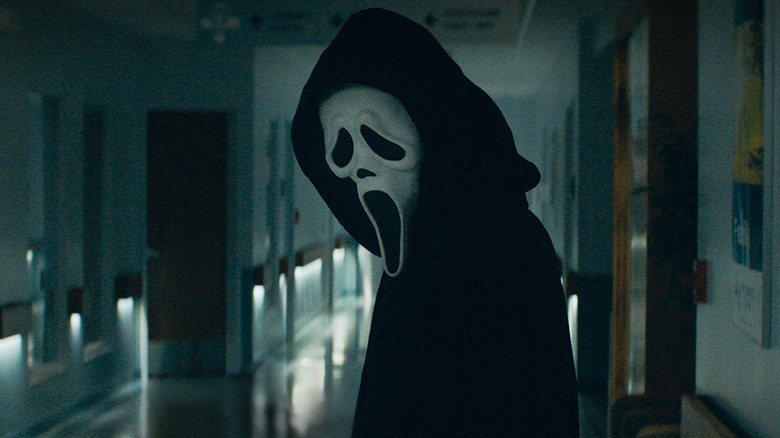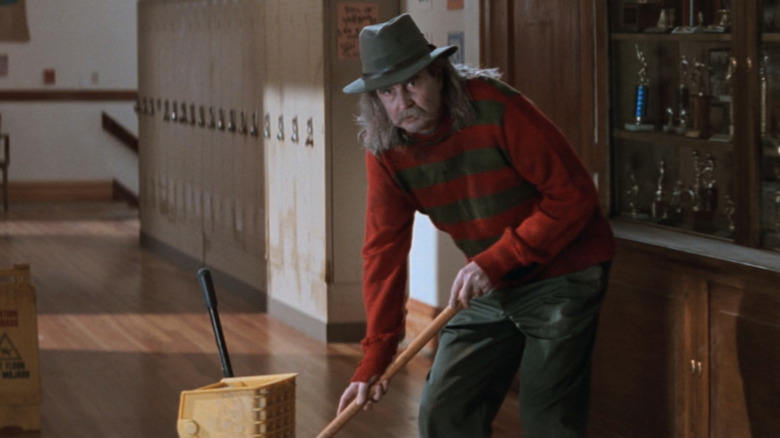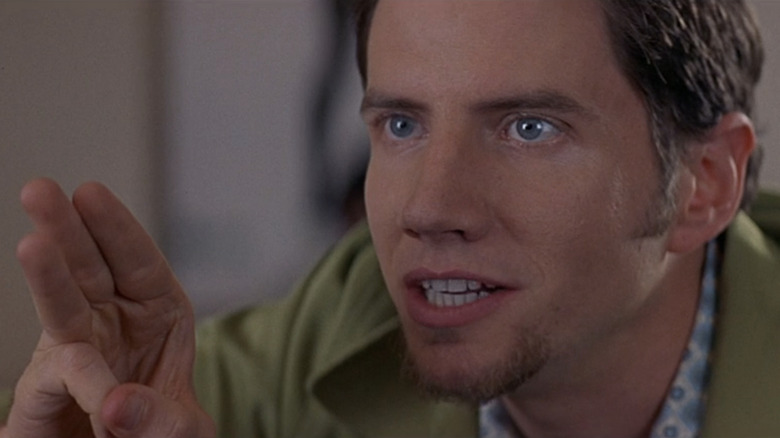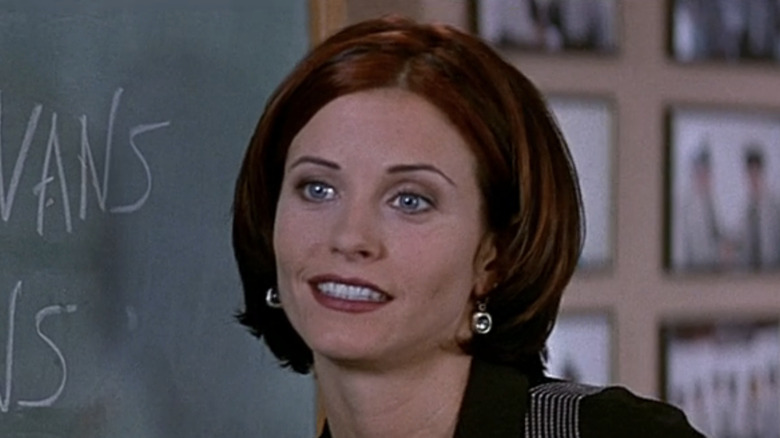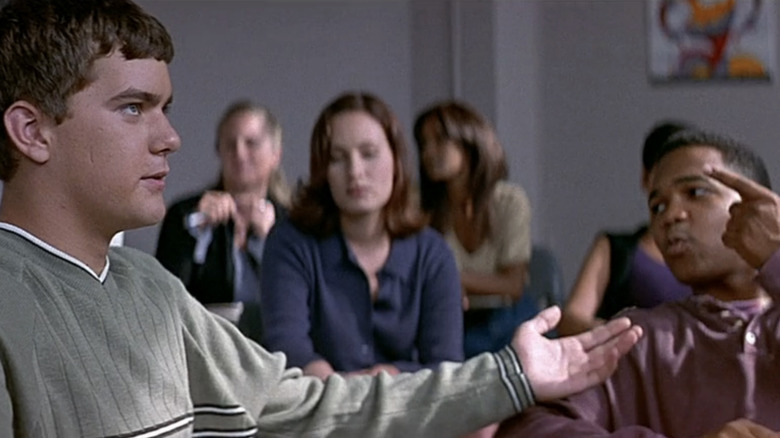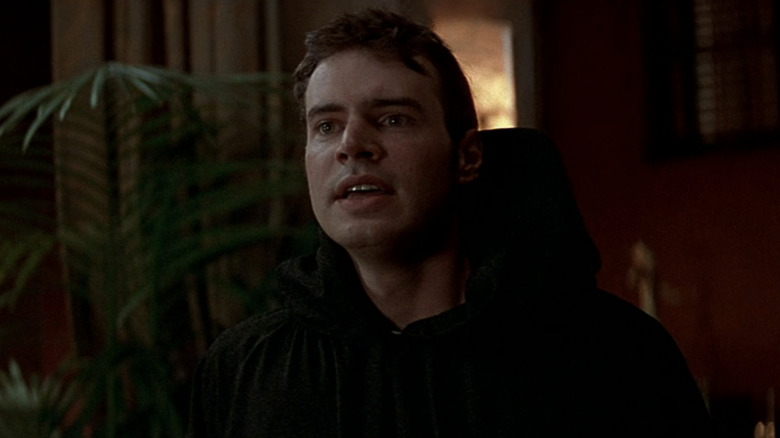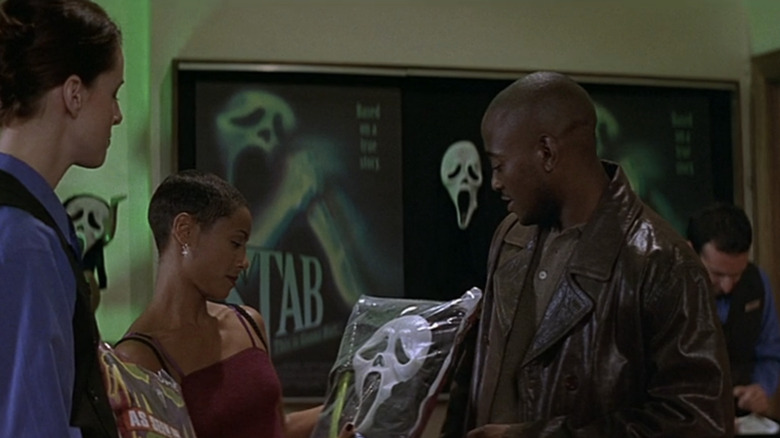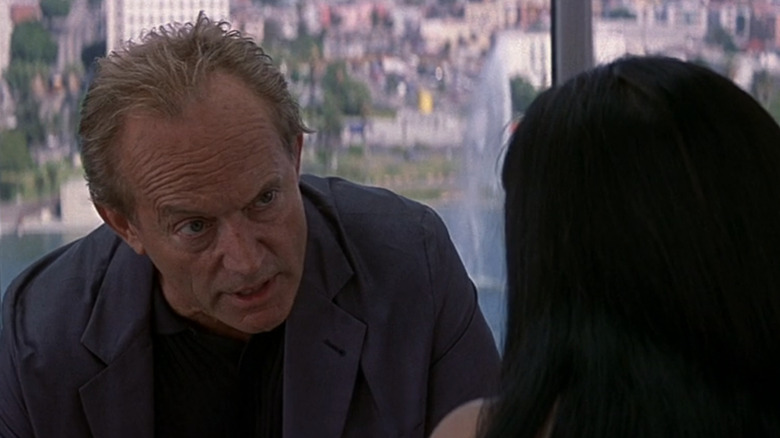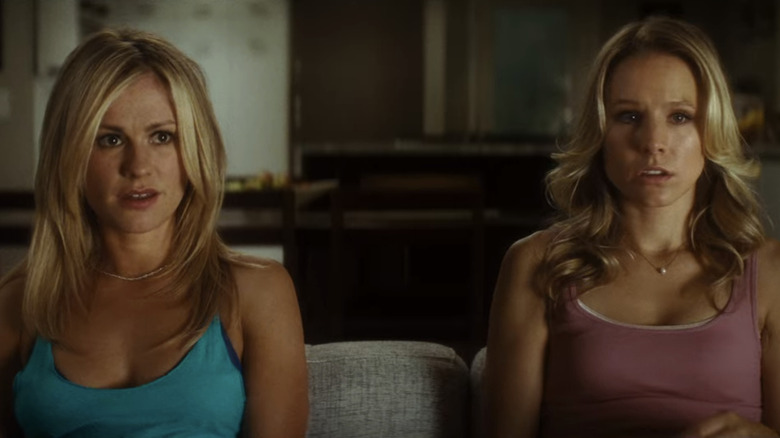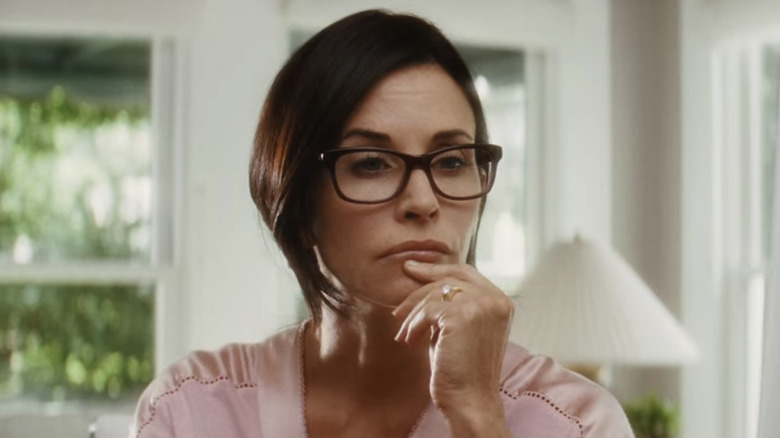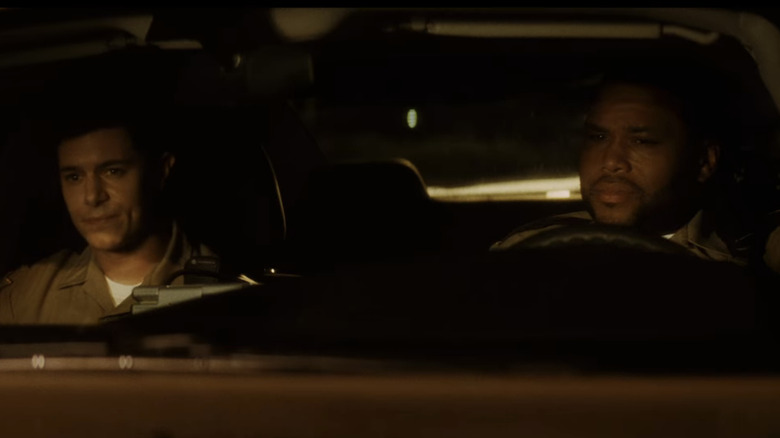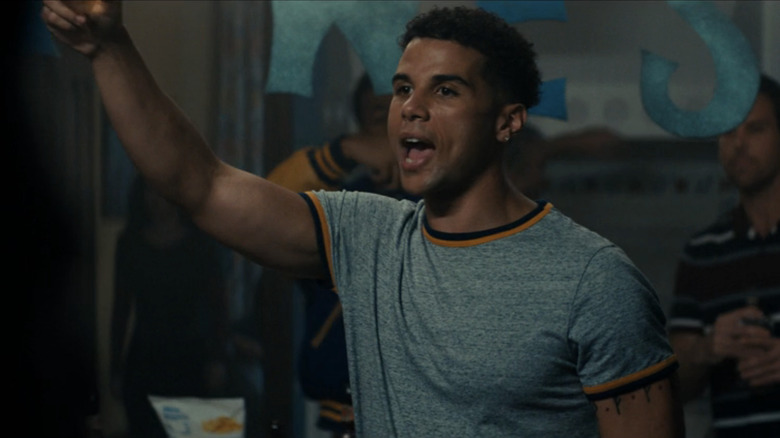The 11 Best Meta Moments In The Scream Movies
If you're in the mood for a good scream, there's no better choice — or at least no more obvious choice — than the "Scream" franchise. Masterminded by horror icon Wes Craven (who directed the first 4) and wunderkind scribe Kevin Williamson (who has had varying degrees of participation in the sequels) as a bittersweet spoof of '80s slasher films, the "Scream" movies have become solid horror flicks on their own, in many ways reinventing the slasher genre.
There's more to the "Scream" series than psychopathic killers and unassuming, sex-crazed teens; the franchise has always been about commenting on the well-traveled cliches of a genre. As the franchise has moved further beyond its initial films, it has increasingly trafficked in meta commentary about itself, calling back to what fans have previously seen in the films, and subverting whatever expectations those developments may have supposedly forecasted.
In the nearly three decades since "Scream" first hit theaters, horror movies have evolved. Craven died in 2015, and in 2022, after a decade of dormancy, filmmakers Tyler Gillet and Matt Bettinelli-Olpin woke it up like Michael Myers sitting up after a supposed killshot. Relatively straightforward jokes about slasher staples have become impassioned arguments for their continued existence in a genre so thoroughly altered by films like "Hereditary," "Midsommer," and "The Babadook."
To justify their genre, the "Scream" films have kept a keen eye on modern horror, held a mirror up to it, and even (maybe especially) held a mirror up to themselves. To celebrate all the slices, stabs, and self-referential sarcasm, here are the best meta moments in the "Scream" movies.
11. Horror legend cameos
Of all of the meta aspects of the "Scream" films, one of the most compelling is their ability to blur the line between reality and story. The audience knows they're watching a movie with characters played by actors, but beyond that hard line, anything goes.
Within the "Scream" films, the characters cite other horror movies and their casts, establishing real-life actors as actors within the "Scream" timeline; sometimes, other horror icons play characters in that world. The overall effect is that, when a new person is introduced on-screen, the audience can't be sure whether they're going to be a new character or simply the actor themself.
One of the very first cameos in the series came in 1996's original film, when one of the reporters seeking a word with Sidney (Neve Campbell) was played by the star of "The Exorcist," Linda Blair. In the same movie, Craven himself appeared, adding an additional meta flair — particularly because he was dressed up in Freddy Krueger's trademark sweater and hat (he created the Krueger character and directed several "Nightmare on Elm Street" films) and named Fred.
In "Scream 3," the character of John Milton was played by Lance Henriksen; the veteran actor played a series of androids and their eccentric creators in the "Alien" franchise.
Such cameos are further immersed in the "Scream" reality by actors in the films having these works referenced by other characters. Billy Loomis (Skeet Ulrich) mentions "The Exorcist," Tara Carpenter (Jenna Ortega) references "A Nightmare on Elm Street," and Randy (Jamie Kennedy) cites "Aliens."
10. Randy's rules
In the first three "Scream" movies, the Randy character exists as something of a cosmic mentor to his fellow teens/twentysomethings.
Wielding an encyclopedic knowledge of horror movies and the recurring motifs within them, his advice to friends (all of them, of course, stuck within their own horror movie) is invaluable and contributes to the survival of many. These rules keep coming up in later films, either through reference by multi-film survivors or by scenes in the fictional "Stab" franchise. By the time they're repeated in the fifth movie, 2022's "Scream," the rules Randy established for horror movies have become an enduring, blatantly meta tradition.
The "how to survive a horror movie" scene in the first "Scream" is the most iconic example of Randy's rules. For the first time on film (at least, so explicitly), here was a character in a horror film telling a group of potential victims how to not die in a horror movie; in 1996, this was an oddly-satisfying moment that echoed countless post-"Friday the 13th" and "Halloween" film viewings by teens all over the world.
Never have sex, never drink or do drugs, never say "I'll be right back" — and you might just live to see the end credits. These were the first set of Randy's rules (with more added in "Scream 2" and in a posthumous video in "Scream 3"), and in many ways, the entire "Scream" franchise was built on the backbone of that refreshing reappraisal of genre conventions.
9. Jennifer Aniston's body
Perhaps the biggest star going into 1996's "Scream" (not named Drew Barrymore) was Courteney Cox, coming off the first two seasons of "Friends." Craven, apparently a fan, made recurring jokes about Cox's "Friends" fame in almost every "Scream" movie.
The most obvious arrives in the early minutes of "Scream 2," during an exchange between Randy and Gale. When Randy brings up alleged nude photos of Gale that leaked online, she fires back that "It was just my head, it was Jennifer Aniston's body." In the same movie, Dewey finds out that the actor playing him in the first "Stab" movie is David Schwimmer, another costar from "Friends," who this time played Cox's character's brother.
Another reference to Cox's Monica days comes in "Scream 3," in which Roman (Scott Foley) tells Jennifer Jolie (Parker Posey), the actress portraying Gale in "Stab," that she can "go back to Must-See TV"; later, Rebecca Walters (Alison Brie) says to Gale, "You WERE my '90s!" a line the real-life Cox has likely heard from a fan or two over the years.
8. Film class
With the goal of creating a trilogy in mind, the second and third "Scream" movies shifted a good portion of their meta moments towards foreshadowing their twists and endings, especially by referencing other trilogies with similar story beats. There's no segment that does this more than the film class scene in "Scream 2," in which a room full of film students discuss how to pull off an effective sequel — if that is even possible for a horror film.
The lively classroom discourse kicks off when Randy proclaims, "'Stab 2?' Who would want to do that? Sequels suck!" In any other movie, that would suffice as its own cheeky little wink at itself, but this series being the way it is, the scene continues.
The class begins listing horror sequels they believe to be better than the original, almost all of which are shot down by their peers, including "House II: The Second Story" and "Aliens." Randy responds by saying that "the entire horror genre was destroyed by sequels," which feels like a bold commentary by Craven himself.
7. There is another Skywalker
The film class scene in "Scream 2" also sets up one of the most easily overlooked but longest-running in-jokes in the series: Could the first three "Scream" movies be intended to mimic the original "Star Wars" trilogy?
The film class discussion about sequels is brought back later by Mickey (Timothy Olyphant), giving Randy a hard-to-argue title better than its predecessor: "The Empire Strikes Back."
Of course, the big twist in that film was the reveal that Darth Vader was Luke Skywalker's father. Likewise, the big reveal at the end of "Scream 2" is that the villain, Debbie Salt (Laurie Metcalf), is secretly the mother of Billy Loomis (Skeet Ulrich).
The parallels become explicit with "Scream 3"; Randy (dead but appearing on videotape), cites "Return of the Jedi" as one of the great trilogy endings. Specifically, he mentions its big twist, though never reveals which twist he means. He's referring to the reveal that Luke Skywalker had a secret sister all along, Princess Leia; "Scream 3" later reveals that Sidney had a secret brother all along, Roman.
Cementing the connection is the movie's cameo by Carrie Fisher, playing a former actress who even admits she looks like Fisher and says she had auditioned for the role of Leia.
6. The Stab franchise
The main vehicle the "Scream" movies created in order to poke fun at themselves in sequels is the "Stab" franchise, based on the "real" murders experienced by Sidney and company and similarly popular with filmgoers who love knives, stars and the blurring of reality.
"Stab" first appears in "Scream 2," after Gale has published a book on the events of the first "Scream" and subsequently sold the movie rights. The first "Stab" retells and (further) hams up the events of the first "Scream"; each ensuing "Stab" film is either a one-to-one analog for a "Scream" movie or a jokey warning of how ridiculous the franchise could become.
The first "Stab" scene audiences see features Heather Graham portraying Drew Barrymore's doomed character in the iconic "Scream" intro. As she goes through (mostly) the same steps as Barrymore's character, a theater audience in "Scream 2" is on hand to point out every stupid decision she makes, reinforcing the first movie's postmodern parody while at the same parodying that movie itself.
Perhaps the most meta moment in the whole "Scream" series comes via a "Stab" scene, in the moments leading up to the murder of Mindy (Jasmin Savoy Brown) in 2022's "Scream." Mindy sits on a couch, watching a scene in the first "Stab" in which Randy also sits on a couch, himself watching a "Halloween" movie. The Stab Randy watches Michael Myers creep up behind Jamie Lee Curtis's character and yells at her to turn around, just as the killer creeps up behind the Stab Randy, causing Mindy to yell at him to turn around — just as the 2022 "Scream" killer creeps up behind Mindy, in this case, killing her.
5. Scream III's sad, unintentional meta moment
One of the most significant meta moments in the franchise comes in "Scream 3." But unlike the rest, it's unintentional and tragic.
The subplot of the third movie revolves around Sidney and Gale gradually peeling back the layers of Sidney's mother's history to discover that she had briefly worked in Hollywood, been the victim of sexual misconduct by a famous producer, and given birth to that producer's child in secret. Unfortunately for "Scream 3," that plot would parallel real-world events that directly affected the series.
The third "Scream" came out in 2000, well before the very public, #MeToo recriminations for sexual misconduct that rocked Hollywood in and around 2020. In something of an ironic twist, that movement was largely fueled by Rose McGowan's accusations against Harvey Weinstein — she, a star of the original "Scream" and he, a producer for the first four movies.
In an onscreen version of events that now feel eerily familiar, the storyline between producer Milton and Sidney's mother ultimately ended in murder, secret children, and the bad guy never standing trial for his crimes. Real-world events ended perhaps somewhat more satisfying, as Weinstein is now serving an extended sentence in prison.
If you or anyone you know has been a victim of sexual assault, help is available. Visit the Rape, Abuse & Incest National Network website or contact RAINN's National Helpline at 1-800-656-HOPE (4673).
4. Everything about Scream IV's opening sequence
Almost every "Scream" movie begins with a sequence featuring a teenage girl or two alone in a big, empty house at night, answering a call from Ghostface, and subsequently dying. But, not content to simply show one or two teens slaughtered at the hands of Ghostface, "Scream 4" begins by getting stabby with three sets of teens in rapid succession, each part of a movie being watched by the following set. It makes for a Russian nesting doll of carnage and convolution.
The film opens on Sherrie (Lucy Hale) and Trudie (Shenae Grimes-Beech), who receive a call from Ghostface and are then murdered. Then the titles hit and the film reveals that those murders were simply the opening to "Stab 6," being watched by Rachel (Anna Paquin) and Chloe (Kristen Bell). Chloe breaks the formula by stabbing Rachel herself, and then more titles roll and viewers learn that this was the opening to "Stab 7," which included a meta-reference to "Stab 6." Then the audience meets Jenny (Aimee Teegarden) and Marnie (Britt Robertson), the "real" teens watching "Stab 7." They are, natch, subsequently murdered by Ghostface.
3. Time to reinvent myself
After the first three "Scream" movies wrapped up the storylines of Sidney, Gale, and Dewey in a fairly conclusive way, the series went dormant. A decade later, the franchise was resurrected with "Scream 4," and by that point, its cast, crew, and entire genre had evolved. The fourth installment had to evolve significantly in order to keep up, and it went out of its way to acknowledge that.
The film begins with an elaborate opening sequence, which contains multiple discussions of how — and importantly, why — horror franchises require reinvention. Protagonists Gale and Sidney have the same discussions, but they of course don't refer to their lives as parts of a horror franchise.
Appearing in a TV interview, Sidney explains to the host that "If I was a victim, it was up to me to reinvent myself." Inspired by Sidney's ambition, Gale also tells herself, "Let's reinvent myself." She follows this with "Except I have no f*****g idea what to write," perhaps echoing some of the actual screenwriters' frustrations in reinventing the franchise.
Those frustrations may have been well-founded. "Scream 4" continued the downward trajectory of the franchise's box-office, becoming the lowest-grossing "Scream" movie. It would be another decade before the franchise was dusted off again, and began turning its fortunes around financially.
2. The cops always get it
About halfway through "Scream 4," a short scene between police officers Perkins (Anthony Anderson) and Hoss (Adam Brody) stuffs itself with more little meta moments than most. In an unusual twist for the series, however, they're not centered around horror movies nearly as much as they are police movies.
While staked out in their squad car, guarding the house of potential victim Jill Roberts (Emma Roberts), Hoss and Perkins appraise their situation from a series of different meta viewpoints. First, they go over what leads to officer deaths in movies, like being a day before retirement, a rookie with a pregnant wife, or leaving while saying "I'll be right back," essentially establishing the police version of Randy's rules.
Hoss also opines that "it sucks to be a cop in a movie unless you're Bruce Willis," and he speaks from experience — Brody had just played a cop in "Cop Out," alongside Willis. Likewise, Hoss... er, Anderson... had recently played a cop in "The Departed," wherein he was one of the only cops to survive to the end. Therefore, when he responds to Hoss with "not all cops die in movies," he speaks from experience.
1. To Wes!
Craven passed away in 2015 at age 76. But that didn't stop his sizable legacy being acknowledged in the fifth entry, 2022's "Scream," nor from receiving an in-universe sendoff in the movie, all thanks to the reverence of his successors, Gillet and Bettinelli-Olpin.
The fifth film introduced Wes Hicks (Dylan Minnette), the teenage son of Deputy Sheriff Judy Hicks (Marley Shelton), who was introduced in "Scream 4." It's clear from the name that his character is a nod to Craven, and that becomes especially apparent as the character displays their horror awareness. When Wes and his mother are murdered by Ghostface (almost certainly how Craven would want any analogous character of his to go), his friends take time to honor him with a group cheer — something no other victim has ever received in one of these movies.
The touching moment takes place during a party at Amber's house, which is later revealed to have once been the house of original killer Stu Macher (Matthew Lillard). Friend Chad (Mason Gooding) raises his shot glass in the air, gets everyone's attention, and yells "To Wes!" Everyone in the room echoes his cheer, and therein lies an even more meta, touching bit of trivia: The voices heard during the cheer include a number of secret cameos from past "Scream" vets, including Brody, Hayden Panettiere, and Henry Winkler.
